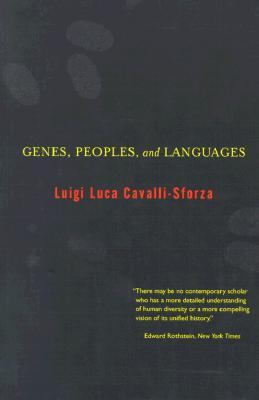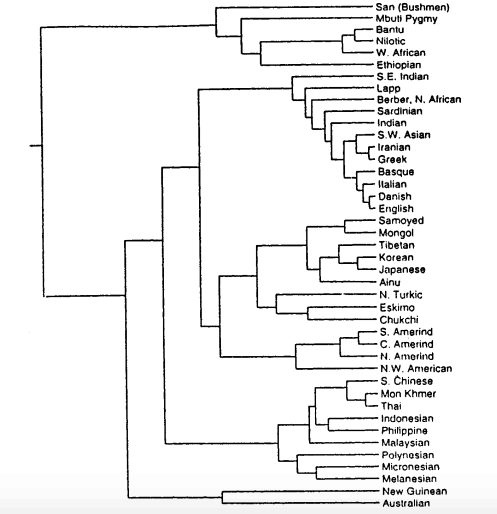Do Genetic Differences Justify Racism?
Glayde Whitney, American Renaissance, August 2000
Genes, Peoples, and Languages, Luigi Luca Cavalli-Sforza (trans. Mark Seielstad), North Point Press, 2000, 228 pp.
In Genes, Peoples, and Languages, Luigi Luca Cavalli-Sforza, has given us a nontechnical overview of what he knows, or thinks he knows — or wants you to think he knows — about genetics and human evolution. Despite his repeated insistence that there is no such thing as race, his work greatly advances our understanding of how races, sub-races, and other populations differ from each other.

Mr. Cavalli-Sforza, born in 1922 and currently Professor Emeritus of Genetics at Stanford University, is one of the world’s most renowned population geneticists, so what he says carries a lot of weight. The six chapters of this little book began as a series of public lectures first delivered in 1981, and rewritten and updated many times. Previously-published versions in French and Italian have been melded into English that flows smoothly and is a pleasure to read. The well-informed specialist will be fascinated by a wealth of personal anecdotes, while the non-specialist will be variously informed and misinformed.
The book is strongest in its explanation of techniques and results from studies of genetic and linguistic diversity. It is weakest — often downright wrong — in its treatment of behavioral development and racial differences. Although the book has a bibliography it has no footnotes.
The book starts right out with what has become Luigi’s trademark: Deny the existence of the very thing he studies. For decades Professor Cavalli-Sforza has repeated the races-do-not-exist mantra while he goes on studying how they differ genetically.
Many people have suggested Professor Cavalli-Sforza denies race so that he can continue his favorite research, and there may be some truth to this. I know that many world-class researchers are terrified of the anti-racial thought police. When I mentioned race differences in a presidential address to the Behavior Genetics Association in 1995, some of my colleagues urged me to resign for the good of the science because they feared I had jeopardized funding for all behavior genetic research. Likewise, a widely-used textbook of behavior genetics claims that Arthur Jensen’s 1969 writing about race and intelligence was a grave threat to the field because it raised the issue of race. By denying race, Professor Cavalli-Sforza can remain on the side of the angels and get research funding; he studies the genetics of populations, not races.
But there may be more to his denial than a simple tactic to keep the money flowing. He seems to see no difference between race as a scientific concept and “racism” as a social phenomenon, and concludes: “It seems wise to me, therefore, to abandon any attempt at racial classification along the traditional lines.” He argues that since each group tends to believe it is the best in the world and to blame other groups for its troubles, it is best not to identify groups at all.
Professor Cavalli-Sforza is at his best when he describes what he does for a living: study genetic variation among groups of people. It was in 1951 that he first started thinking about building evolutionary family trees based on distributions of genes. In 1962 he worked with Anthony Edwards trying to base these trees on real genetic data. This involved advanced statistical methods such as principal-components analysis and multidimensional scaling. These different methods approach the data from different directions and on the basis of different assumptions, so if their results converge investigators are probably on the right track.
These procedures are complex and require a great deal of computation. Professor Cavalli-Sforza writes that some had been known for years, but were almost never used before computers because of the “staggering amount of arithmetical work.” It is difficult to explain these methods to non-mathematicians, but like other outstanding people who really understand their material, Professor Cavalli-Sforza has a knack for simple explanations. For example, at the heart of all the math is the goal of determining genetic distances between populations — but what is genetic distance?
Consider an example using the well-known gene with different forms that represent the major blood groups, A, B, and O. The frequency for A is 25 percent (.25) for Englishmen, and about two percent (.02) for American Indians. Based on the distribution of this one gene form or allele, the genetic distance between Englishmen and Amerinds is the difference between the allele frequencies: .25 — .02 = .23. However, for the “B” allele, the English are at eight percent (.08), while Amerinds are point three percent (.003). So the genetic distance estimated from the distribution of the B allele is .08 — .003 = .077. Interestingly, the ratios of the results for these two examples are similar: .92 and .96 (.23/.25 = .92 and .077/.08 = .96).
So what is the overall, or average, genetic distance between Englishmen and Indians: 23 percent or 7.7 percent, or ninety-something percent, or what? Complex statistical methods use values for many alleles of many genes from many populations to calculate estimates of genetic distances.
For his monumental work The History and Geography of Human Genes (1994) Professor Cavalli-Sforza and colleagues collected data for about 100,000 gene frequencies from approximately 2,000 populations around the world. They worked with distributions of what genes produce — protein polymorphisms (blood antigens, enzymes, structural proteins, etc.) — rather than DNA from the genes themselves, but newer techniques will allow similar work to be done directly with genes.
Professor Cavalli-Sforza uses other approaches to understand human evolution — archeology, fossil remains, and the study of languages also help reconstruct the past. Today there are over 5,000 spoken languages and some, like English, are very widespread while others are spoken by fewer than a hundred people. Languages have interconnected histories, much as biological populations do. For example, the romance languages — Italian, French, Spanish, Romanian — derive from a common source, Latin. The Germanic language family includes Dutch, English, Flemish, German, and Swedish. People who speak related languages tend to be biologically related, and data on languages can be subjected to statistical analysis similar to that used with genes to find distances between them. We now know there are important similarities between the evolution of languages and genes. Each can be used to help understand and confirm the other.
The detailed results of Prof. Cavalli-Sforza’s fascinating work have been reported in The History and Geography of Human Genes (discussed by Glayde Whitney here) and are summarized in his current book. One interesting and well-substantiated finding is that sub-Saharan Africans are the group that is most distant genetically from all other humans. This conclusion is consistent with Charles Darwin’s observation that the differences between African Blacks and Europeans are so great that any taxonomist would consider them separate species, were it not for their willingness to hybridize.
Professor Cavalli-Sforza is a great scientist and his work has done much to advance our knowledge of the genetics of evolution. It is therefore saddening to encounter so many errors when he approaches politically sensitive territory. Some of these errors are so egregious they suggest a desire to deceive.
For example, in making his there-are-no-races argument Professor Cavalli-Sforza energetically attacks the straw man of racial purity. It is true that some pre-genetic biologists and politicians have talked about pure races, but Professor Cavalli-Sforza writes as if they thought there were “pure” groups with no genetic variation. It has been well known for a long time that all naturally existing, sexually-reproducing groups harbor a great deal of genetic diversity. German Shepherds are consistently different from Irish Setters, but both breeds have lots of genetic variation within them. At the same time, “pure breeds” of dogs and “racially pure” stocks of humans can exist despite the extensive genetic variation within each group. After all, Professor Cavalli-Sforza acknowledges that it is “fairly easy to recognize a European, an African, and an Asian,” (in fact, a child of five can tell them apart unerringly). So, given that reliable race (oops, population) differences — pure groups — do exist, the fallback position is to claim that the differences are only skin deep.

Genetic Distance between these 42 population groups is represented by the length of the line that must be traveled to get from one population to another. Prof. Cavalli-Sforza’s work results in charts like this-which almost perfectly parallel the traditional racial groupings based on physical anthropology-yet he persists in claiming that race does not exist.
Genetic Distance between these 42 population groups is represented by the length of the line that must be traveled to get from one population to another. Prof. Cavalli-Sforza’s work results in charts like this-which almost perfectly parallel the traditional racial groupings based on physical anthropology-yet he persists in claiming that race does not exist. This chart is so important it has been reproduced in two previous issues of AR.
“Each ethnic group has been genetically engineered under the influence of the environments where it settled,” writes Professor Cavalli-Sforza. The light skin of Europeans, for example, is useful in cloudy, overcast regions because the sun’s weak ultraviolet radiation can penetrate it and make vitamin D. It would be a handicap in a tropical climate where too much penetration of radiation can cause skin cancer. In hot, humid regions it helps to be tall and thin because the high surface-to-volume ratio of the body helps sweat evaporate. Smaller bodies use less energy and produce less heat. “Frizzy hair” allows sweat to remain on the scalp longer, which improves cooling. Pygmies are an extreme example of the rule that tropical forest people tend to be short, whereas “the face and body of the Mongols, on the other hand, result from adaptations to the bitter cold of Siberia.”
But after this promising beginning, Professor Cavalli-Sforza falls off the tracks with the allegation that “adaptations to climate primarily affect surface characteristics.” This unsupported but commonly-made claim arises from the fact that surface traits are easier to study then psychological tendencies or mental abilities. Historically, the surface traits were investigated first, and the lack of knowledge of more difficult traits has led, in the hands of ideologues, to the silly non sequitur that if races are very different in surface traits, it means they must be the same for traits below the surface. In fact, given what we know about the biological underpinnings of mental traits, it requires a colossally ideological effort to insist that the brain is the only human organ that does not vary from one group to another.
The discussion of intelligence in relation to genes and race is not only wrong, it is 180 degrees opposed to recent findings. Professor Cavalli-Sforza takes it as gospel that Sir Cyril Burt’s twin research on the heritability of intelligence was faked. In fact, the Marxist Professor Leon Kamin’s posthumous attack on Burt’s legacy has been largely disproven. Furthermore, new and totally independent research completely supports Burt’s findings of a heritability for intelligence of .7 or more, a figure Professor Cavalli-Sforza seems to think depends solely on Burt’s research.
Professor Cavalli-Sforza goes on to say that “the study of adopted children was decisive in showing that cultural transmission exerts a strong influence on the determination of IQ.” In fact, this very research has lead to the surprising conclusion that there is no evidence of a family effect (“cultural transmission”) on IQs of adopted children (AR, May, 1998). Sandra Scarr, emerita of the University of Virginia, has done the most thorough research of this kind. Of black babies adopted into upper-middle class white families, she writes:
The test performance of the Black/Black adoptees [adopted children with two black parents] was not different from that of ordinary Black children reared by their own families in the same area of the country. My colleagues and I reported the data accurately and as fully as possible, and then tried to make the results palatable to environmentally committed colleagues. In retrospect, this was a mistake.
Professor Cavalli-Sforza also gets it backwards when he writes: “Theories about the role IQ plays in social stratification have also been disproved. Some researchers have claimed, without real evidence, that the difference in IQ observed between high and low social classes was genetic.”
Professor Cavalli-Sforza also writes regretfully that with regard to the low IQ of black Americans, “the majority is likely to be still convinced that it is the result of a real genetic difference . . . that cannot be reversed in a short time.” Indeed, despite a half-century of brainwashing many of us can still think for ourselves.
Despite his obvious determination to toe the egalitarian line, Professor Cavalli-Sforza occasionally does follow scientific conclusions dangerously close to political incorrectness. To his credit, he writes that “a race is a group of individuals that we can recognize as biologically different from others.” Then he goes on to concede that if “genetic differences were found to be genuinely important and could support the sense of superiority that one people can have over another, then racism is justified — at least formally.” He has therefore staked his entire case against “racism” on the absurd conviction that genes for different abilities are distributed precisely evenly through all racial groups. Current research has already proven him wrong, and further progress in the Human Genome Project is likely to make it scientifically impossible to maintain the egalitarian position. If differences justify “racism,” Professor Cavalli-Sforza had better be preparing for a great deal of it.
















